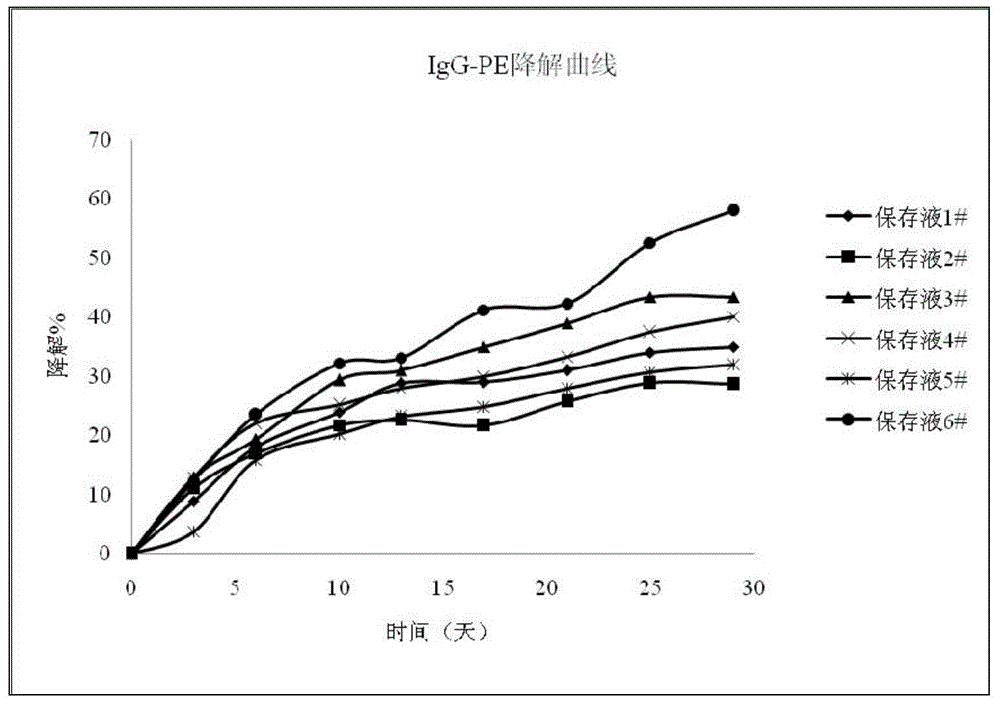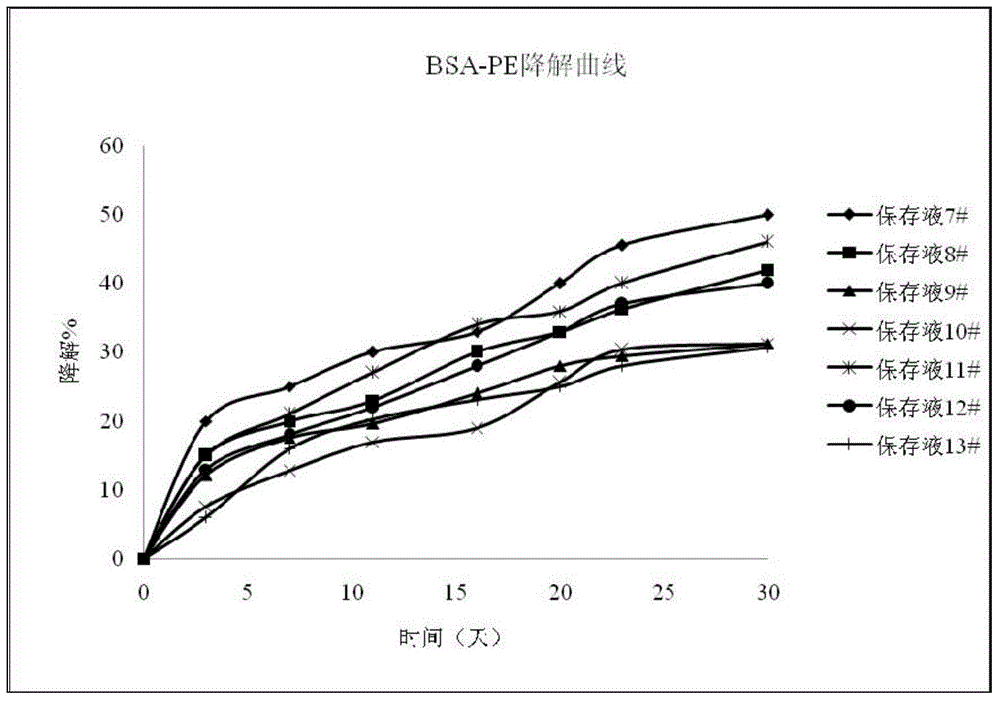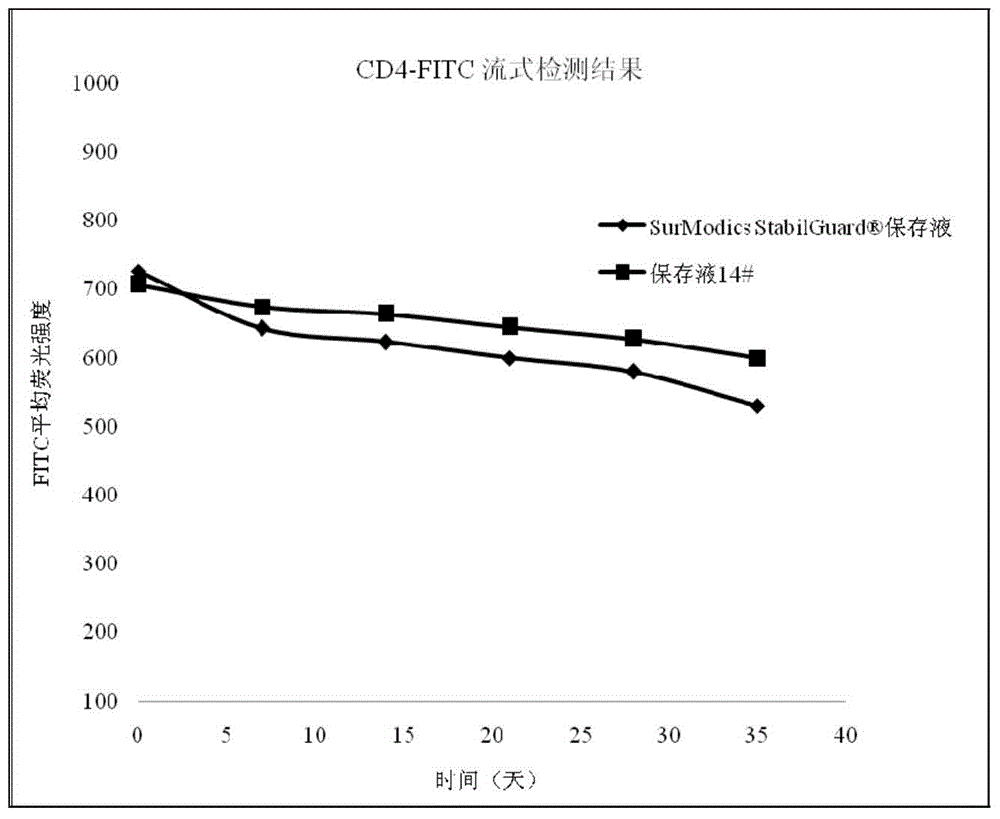Biomarker preserving liquid, biomarker reagent and method
A biomarker and preservation solution technology, which is applied in the preservation of human or animal bodies, biological testing, material inspection products, etc., can solve the problems of poor preservation effect, achieve the effect of convenient use and cost reduction
- Summary
- Abstract
- Description
- Claims
- Application Information
AI Technical Summary
Problems solved by technology
Method used
Image
Examples
preparation example Construction
[0058] Preparation method of fluorescent marker reagent
[0059] Yet another embodiment of the present invention discloses a method for preparing a fluorescent marker reagent, comprising:
[0060] Provide the above preservation solution and fluorescent tracer-biomarker conjugate;
[0061] Dilute the fluorescent tracer-biomarker conjugate to the working concentration with the preservation solution to obtain a fluorescent marker reagent solution that can be used directly.
[0062] Preferably, the fluorescent tracer-biomarker conjugate is a fluorescently labeled protein, particularly preferably, a fluorescently labeled antibody.
[0063] In the following, a fluorescently labeled protein is taken as an example for illustration.
[0064] Mix fluorescently labeled protein with other components as needed, dissolve in water, and prepare fluorescently labeled protein master solution. Weigh each component of the above storage solution, add water and stir to dissolve, and dilute wit...
Embodiment 1
[0095] According to the formula in Table 1, prepare 1#~6# preservation solutions, stir, dissolve and filter at room temperature, and set aside. Prepare self-made fluorescent protein-labeled polyclonal antibody IgG-PE reagents according to conventional methods. Dilute the self-made fluorescent protein-labeled polyclonal antibody IgG-PE reagent with 1~6# preservation solution respectively to a solution of 12.5 μg / mL. The diluted fluorescently labeled polyclonal antibody reagent solution was divided into 9 small portions (50 μL each) and placed in the dark at 40°C. Take a reagent solution every 3 to 4 days and detect the fluorescent tracer according to the aforementioned method- The peak area of the protein conjugate was used to calculate the degradation percentage of the fluorescent tracer-protein conjugate over time, and the curve of time and degradation percentage was drawn.
[0096] Test results such as figure 1 As shown, the degradation percentage of the fluorescent trac...
Embodiment 2
[0101] Prepare 7#~13# preservation solutions according to the formula in Table 2, stir, dissolve and filter at room temperature, and set aside. Fluorescence-labeled protein BSA-PE reagents were prepared according to conventional methods. Dilute the self-made fluorescently labeled protein BSA-PE reagent with 7~13# preservation solution to a solution of 12.5 μg / mL. The diluted fluorescently labeled protein reagent solution was divided into 8 small portions (50 μL each) and placed in the dark at 40°C. Take a portion of the reagent every 3 to 7 days and detect the fluorescent tracer-protein conjugate according to the above method. Calculate the degradation percentage of the fluorescent tracer-protein conjugate with time, and draw the curve of time and degradation percentage.
[0102] Test results such as figure 2 As shown, the degradation percentage of the fluorescent tracer-protein conjugate reflects the stability of the fluorescent tracer-protein conjugate and the stability o...
PUM
 Login to View More
Login to View More Abstract
Description
Claims
Application Information
 Login to View More
Login to View More - Generate Ideas
- Intellectual Property
- Life Sciences
- Materials
- Tech Scout
- Unparalleled Data Quality
- Higher Quality Content
- 60% Fewer Hallucinations
Browse by: Latest US Patents, China's latest patents, Technical Efficacy Thesaurus, Application Domain, Technology Topic, Popular Technical Reports.
© 2025 PatSnap. All rights reserved.Legal|Privacy policy|Modern Slavery Act Transparency Statement|Sitemap|About US| Contact US: help@patsnap.com



